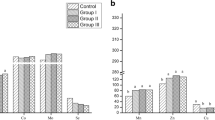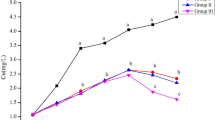Abstract
Copper (Cu) is an essential trace element, but excessive Cu intake can induce poor performance and Cu poisoning and result in various health problems. Cu and molybdenum (Mo) antagonize each other in vivo. Therefore, Mo can reduce the absorption and utilization of Cu. The aims of this study were to investigate the impacts of Mo fertilization on antioxidant capacity of grazing Nanjiang brown goat on Cu-polluted meadow and explore the control methods of Cu pollution in natural pasture. Fertilization and grazing experiments were carried out in Liangshan Yi Nationality Prefecture of the Western Sichuan Plateau, Sichuan Province, Southwest China. Cu-polluted meadows of 12 hm2 were fenced, and randomly divided into two groups (3 replications/group, 2 hm2/replication), control group and treatment group, fed with basic diets supplemented with 0 and 3 kg Mo/hm2 [ammonium molybdate tetrahydrate, (NH4)6Mo7O24·4H2O], respectively. In the current study, 36 healthy Nanjiang brown goats (1 year old, 32.8 ± 1.1 kg) were randomly divided into two groups (3 replications/group, 6 goats/replication) and assigned to the experimental pastures. The grazing experiment lasted for 60 days. The results showed that the concentration of Mo in soil in treatment group was 96.28 mg/kg, far exceeding the normal levels. At days 30 and 60, the levels of Hb, RBC, and PCV in blood in treatment group and the activities of serum SOD, GSH-Px, T-AOC, CAT, and Cp were higher than those in control group (P < 0.01). The MDA content in treatment group was lower than that in control group (P < 0.01). The contents of Cu in blood and liver in treatment goats were lower than those in control animals (P < 0.01). The contents of Zn and Mo in blood and liver in treatment goats were higher than those in control animals (P < 0.01). The Mn content in liver in treatment group was higher than that in control animals (P < 0.01). These results indicated that fertilization of (NH4)6Mo7O24 not only markedly influenced the mineral contents in blood and liver, but also extremely improved antioxidant capacity of grazing Nanjiang brown goat from fertilized pastures and relieved the damage caused by Cu pollution.
Similar content being viewed by others
Data Availability
The datasets generated during and/or analyzed during the current study are available from the corresponding author on reasonable request.
References
Gao JQ, Yu Y, Wang DH, Liu LJ (2019) The content and distribution characteristics of heavy metals in root soils in the Jiajika Lithium Resource Area, Western Sichuan Province. Rock Miner Anal 38(6):381–392
Liu J (2010) Heavy metal contamination of soils and bioaccumulation by dominant plants in copper mines in Western Sichuan. Sichuan Agricultural University, Yaan
Du J, Wang ZK, Liu J, Zhong SQ, Wei CF (2020) Distribution characteristics of soil heavy metals, their source identification and their changes influenced by anthropogenic cultivation activities in Purple Hilly Regions of Sichuan Basin, China. J Soil Sci Plant Nutr 20(3):1080–1091
Zhao XG, Li ZL, Wang DL, Li J, Zou B, Tao Y, Lei LM, Qiao FY, Huang J (2019) Assessment of residents' total environmental exposure to heavy metals in China. Sci Report 9(1):10386
Wu P, Jiang LY, He Z, Song Y (2017) Treatment of metallurgical industry wastewater for organic contaminant removal in China: status, challenges, and perspectives. Environ Sci-Water Res Technol 3(6):1017–1031
Gall JE, Boyd RS, Rajakaruna N (2015) Transfer of heavy metals through terrestrial food webs: a review. Environ Monit Assess 187(4):1–21
Shen XY, Song CJ, Wu T (2020) Effects of nano-copper on antioxidant function in copper-deprived Guizhou black goats. Biol Trace Elem Res 199:2201–2207. https://doi.org/10.1007/s12011-020-02342-1
Shen XY, Chi YK, Xiong KN (2019) The effect of heavy metal contamination on humans and animals in the vicinity of a zinc smelting facility. PLoS One 14(10):e0207423
Song CJ, Gan SQ, He J, Shen XY (2021) Effects of nano-zinc on immune function in Qianbei-pockmarked goats. Biol Trace Elem Res 199(2):578–584
Zhou SH, Zhang CY, Xiao QY, Zhuang Y, Gu XL, Yang F, Xing CH, Hu GL, Cao HB (2016) Effects of different levels of molybdenum on rumen microbiota and trace elements changes in tissues from goats. Biol Trace Elem Res 174(1):85–92
Yuan R (2012) Effect of fertilizer treatment to copper pollution meadow on copper metabolism in Guizhou semi-fine wool sheep. Lanzhou University, Lanzhou
Lee MT, Lin WC, Yu B, Lee TT (2017) Antioxidant capacity of phytochemicals and their potential effects on oxidative status in animals — a review. Asian-Australas J Anim Sci 30(3):299–308
Song CJ, Gan SQ, Shen XY (2020) Effects of nano-copper poisoning on immune and antioxidant function in the Wumeng semi-fine wool sheep. Biol Trace Elem Res 198(2):515–520
Chen JQ, Xu YM, Han Q, Yao YC, Xing HJ, Teng XH (2019) Immunosuppression, oxidative stress, and glycometabolism disorder caused by cadmium in common carp (Cyprinus carpio L.): application of transcriptome analysis in risk assessment of environmental contaminant cadmium. J Hazard Mater 366:386–394
Jiao H, Xu J, Xing T (2019) Impaired immune function and structural integrity in the gills of common carp (Cyprinus carpio L.) caused by Chlorpyrifos exposure: through oxidative stress and apoptosis. Fish Shellfish Immunol 86:239–245
Zhu ZM, Chen JB, Li TX, Chen L, Ma DH (2011) Resource and environmental significance of heavy metals in Lala copper mine tailings. Rock Miner Anal 30(1):43–48
Zhao ZQ, Sun Y, Niu G, Sun JD, Kang CX, Gong JC (2010) The evaluation and prevention of heavy metal pollution on development of metal mine—the case of LaLa copper mine in Sichuan. Metal Mine 1:142–146
Huo B, Wu T, Chi YK, Ming XY, Shen XY (2019) Effects of molybdenum fertilizer application on copper metabolism of Wumeng semi-fine wool sheep in copper polluted grassland. J Dom Anim Ecol 40(7):44–49
Zhang SK (2012) The Effect of different concentrate to roughage ration on milk fat / milk protein of lactating goats and its mechanism. Nanjing Agriculture University, Nanjing
Chi YK, Zhang ZZ, Song CJ, Xiong KN, Shen XY (2020) Effects of fertilization on physiological and biochemical parameters of Wumeng sheep in China’s Wumeng prairie. Pol J Environ Stud 29(1):79–85
Wang YC, Jiang L, Li YF, Luo XY, He J (2016) Effect of different selenium supplementation levels on oxidative stress, cytokines, and immunotoxicity in chicken thymus. Biol Trace Elem Res 172:488–495
Li YF, He J, Shen XY (2020) Effects of nano-selenium poisoning on immune function in the Wumeng semi-fine wool sheep. Biol Trace Elem Res. https://doi.org/10.1007/s12011-020-02408-0
Yuan R, Li LJ, Wang QW, Du GZ (2010) Copper deficiency in Guizhou semi-fine wool sheep on pasture in south west China karst mountain area. Afr J Biotechnol 10(74):17043–17048
Shen XY (2011) Studies of wool-eating ailment in Guizhou semi-fine wool sheep [J]. Agric Sci China 10(10):168–1623
GB 15618-2018. Soil environmental quality risk control standard of soil contamination of agricultural land (Trial). Beijing, Ministry of Ecology and Environment of the People’s Republic of China
Song CJ, Shen XY (2020) Effects of environmental zinc deficiency on antioxidant system function in Wumeng semi-fine wool sheep. Biol Trace Elem Res 195:110–116
Shen XY, Huo B, Li YF, Song CJ, Wu T, He J (2021) Response of the critically endangered Przewalski’s gazelle (Procapra przewalskii) to selenium deprived environment. J Proteome 241:104218. https://doi.org/10.1016/j.jprot.2021.104218
Zhao K, Chi YK, Shen XY (2020) Studies on edema pathema in Hequ horse in the Qinghai-Tibet Plateau. Biol Trace Elem Res 198(1):142–148
Zhao K, Huo B, Shen XY (2020) Studies on antioxidant capacity in selenium-deprived the Choko yak in the Shouqu prairie. Biol Trace Elem Res. https://doi.org/10.1007/s12011-020-02461-9
Shen XY, Huo B, Wu T, Song CJ, Chi YK (2019) iTRAQ-based proteomic analysis to identify molecular mechanisms of the selenium deficiency response in the Przewalski's gazelle. J Proteome 203:103389
Huma N, Sajid A, Khalid A, Wardah H, Moazama B, Shakeela P, Sadia M, Sajida M (2019) Toxic effect of insecticides mixtures on antioxidant enzymes in different organs of fish, Labeo rohita. Pak J Zool 51:1355–1361
Huo B, Wu T, Song CJ, Shen XY (2019) Effects of selenium deficiency in alpine meadow on blood biochemical indexes and antioxidant systems of yaks. China Anim Husband Veter Med 46(04):1053–1062
Song CJ, Jiang Q, Shen XY (2021) Responses of Przewalski's gazelle (P. przewalskii) to zinc nutrition in physical habitat. Biol Trace Elem Res 199(1):142–147
Kananfchian M, Esmaeilzadeh S, Mahjoub S (2020) Status of serum copper, magnesium, and total antioxidant capacity in patients with polycystic ovary yndrome. Biol Trace Elem Res 193:111–117
Li YF, Wang YC, Shen XY (2021) Effects of sulfur fertilization on antioxidant capacity of Wumeng semi-fine wool sheep in the Wumeng Prairie. Pol J Environ Stud
Soetan KO, Olaiya CO, Oyewole OA (2020) The importance of mineral elements for humans, domestic animals and plants – a review. Afr J Food Sci 4(5):200–222
Lv AJ, Yang ZB, Yang WR, Jiang SZ, Zhang GG, Zhan ZF (2005) Effects of different dietary levels of copper and molybdenum on the activity of serum ceruloplasmin and plasma sod in small-fat-tail sheep. Chin J Anim Sci 17(1):61–64
Kan XQ, Dong YQ, Feng L, Zhou M, Hou HB (2021) Contamination and health risk assessment of heavy metals in China's lead-zinc mine tailings: a meta-analysis. Chemosphere 267:128909
Minervino AH, López-Alonso Barrêto Júnior R, Rodrigues FAM, Araújo CAS, Sousa R, Mori C, Miranda Oliveira FL, Antonelli A, Ortolani E (2019) Dietary zinc supplementation to prevent chronic copper poisoning in sheep. Animals 8(12):227
Ryssen JBJV, Malsen SV, Barrowman PR (1986) Effect of dietary molybdenum and sulphur on the copper status of hypercuprotic sheep after withdrawal of dietary copper. Boletín De La Asociación Médica De Puerto Rico 69(1):4–9
Dick AT (2010) Preliminary observations on the effect of high intakes of molybdenum and of inorganic sulphate on blood copper and on fleece character in crossbred sheep. Aust Veter J 30(7):196–202
Shen XY, Min XY, Zhang SH, Song CJ, Xiong KN (2020) Effect of heavy metal contamination in environment on antioxidant function in Wumeng semi-fine wool sheep in the southwest China. Biol Trace Elem Res 198(2):505–514
Li YF, He J, Luo L, Wang YC (2021) The combinations of sulfur and molybdenum fertilization improved antioxidant capacity in grazing Nanjiang brown goat. https://doi.org/10.1007/s12011-021-02702-5
Funding
This work was supported by the Innovation and Development Supporting Plan Project of Key Industries in Southern Xinjiang (2021DB014), and the National Natural Science Foundation of China (41671041).
Author information
Authors and Affiliations
Contributions
Yuanfeng Li: conceptualization, methodology, investigation, software, data curation, formal analysis, resources, writing-original draft, preparation; Xiaoyun Shen: visualization, investigation, formal analysis, writing-reviewing & editing, funding acquisition; Fuyuan Liu: data curation, writing-reviewing & editing; Lan Luo: validation, investigation; Yachao Wang: supervision, conceptualization, methodology, investigation, project administration, resources, writing-reviewing & editing.
Corresponding author
Ethics declarations
The protocol for the present experiment was approved by the Institutional Animal Care and Use Committee of Southwest University of Science and Technology.
Conflict of Interest
The authors declare no competing interests.
Additional information
Publisher’s Note
Springer Nature remains neutral with regard to jurisdictional claims in published maps and institutional affiliations.
Yuanfeng Li and Xiaoyun Shen are equal contributors, they are co-first authors
Rights and permissions
About this article
Cite this article
Li, Y., Shen, X., Liu, F. et al. Molybdenum Fertilization Improved Antioxidant Capacity of Grazing Nanjiang Brown Goat on Copper-Contaminated Pasture. Biol Trace Elem Res 200, 1156–1163 (2022). https://doi.org/10.1007/s12011-021-02735-w
Received:
Accepted:
Published:
Issue Date:
DOI: https://doi.org/10.1007/s12011-021-02735-w




